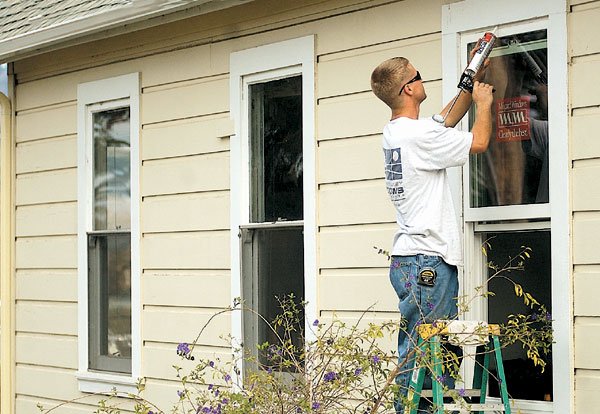Cooler weather means more than winter coats. Think dual-pane
windows, weather stripping and outdoor doggy homes
By Kelly Savio Staff Writer
As temperatures dip and people start digging out thick winter comforters, other signs of winter make themselves apparent in sometimes not-so-pleasing ways. Before the cold season officially arrives, now is a good time to do a quick inventory of your home and see if it is ready for the chill.
One sure sign of winter is the distinct bite in the air. Nippy temperatures inside your house can be a sign that old, single-pane windows or weather stripping has gone bad, said Ron McClellan, owner of L&M Windows in Morgan Hill. Several homes in the area are older and were built before double-pane, energy-efficient windows became popular, he said.
By upgrading windows and checking that weather stripping is still intact around the windows and doors of a home, people can save up to 30 percent on their energy bills, McClellan said – which will be even more significant this winter because natural gas prices are up 50 to 70 percent from last year.
Lowering your energy bills can even earn you money this year through a new incentive program from PG&E. Customers who reduce their natural gas usage by 10 percent during January, February and March will get a 20 percent rebate from PG&E, said Jeff Smith, PG&E spokesperson.
To keep the heat inside and the cold outside, try dual-pane windows, McClellan said.
“Some people try to compensate for old windows with heavier drapes, but that ultimately doesn’t work,” McClellan said. “If you have dual-pane windows that have a liquid coating on them, you’ve got more barriers, and it slows the heat transfer from outside to inside.”
Upgrading windows will save you money on air conditioning in the summer when they act in reverse, preventing the heat outside from coming in, he added.
In the average home, installing energy-efficient windows takes about two to three days. The American Architectural Manufacturers Association certifies the windows and the companies that install the windows, McClellan said, adding that it’s important to check for these certifications before hiring a company to do the installation.
“I would say for an average home of about eight windows and a patio door, you’re looking at spending about $5,600 to $5,800,” said Joe Doyle, one of the owners of South Valley Windows in Gilroy.
“It would probably be less than half that to replace single-pane windows with new single-pane windows, but then you don’t have the insulation.”
Dual-pane windows will pay for themselves over time, Doyle said, as customers won’t be using their heaters as much, and the savings on natural gas can be significant.
Just as people try to keep warm inside their homes during the winter, so do unwanted creepy-crawlers. The cold and the rain drive insects such as ants and spiders indoors for shelter, said Travis Mickel, manager of Clark Pest Control in Salinas. Rodents can also be a problem.
About 800 people in Hollister alone employ Clark to try to keep the pests out when the inclement weather arrives, Mickel said. Although there’s no such thing as an entirely bug-free house, he said, you can prevent most insects from crawling inside by making sure you have well-maintained, quality weather stripping in your home, as well as checking that cracks and crevices are well-caulked.
Sometimes, when people see an obvious entry point for insects, they’ll spray a potent insect-repellent on the spot and think the problem is solved. However, spraying might actually make it worse, Mickel said. Though the insects won’t come in through that particular location, they will probably find another place that may be harder for people to notice. By the time their new point of entry is noticed, the insects already may have made a nest.
There is no single prescription for every house to keep bugs out. If your home is prone to insect invasion, consider getting a professional’s opinion on how to keep the critters out, Mickel said. If you have minor pest problems, treat areas where bugs are likely to come in, such as around water pipes, under the sink and through air vents.
Though some creatures inside your home are not welcome, others are: your pets. Make sure your furry friends are ready for winter, particularly those that spend most of their time outside.
If pets spend a considerable amount of time outdoors, they should have an enclosed area with at least three sides to protect them from the elements, said Brad Webb, a veterinary assistant at Gilroy Veterinary Hospital. A cold wind is far more problematic than wet weather because the wind-chill factor moves body heat away from animals faster than rain.
A small-sized enclosed area is better than a large one, Webb said, because an animal’s body heat can warm the area faster.
Cats may or may not choose to take advantage of a provided enclosure to escape the elements, Webb said, but it doesn’t hurt to provide one anyway.
If your pet is less than 30 pounds, give it a heat lamp to make sure it stays warm enough, Webb said. Look for a lamp with a built-in timer so it doesn’t stay on all the time. Pets also should have easy access to fresh water at all times.














